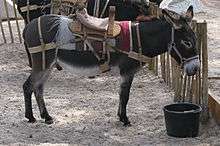Corsican donkey
The Corsican Donkey, French: Âne corse, Corsican: U sumeru corsu, is a breed of domestic donkey from the Mediterranean island of Corsica, a région and territorial collectivity of France. It is not recognised by the Ministère de l'agriculture, de l'agroalimentaire et de la forêt, the French ministry of agriculture, or by the Haras Nationaux, the French national stud;[3] nor is it reported to the DAD-IS database of the FAO.[4] Its numbers have fallen alarmingly; two associations are seeking its official recognition as a breed.
 | |
| Conservation status | |
|---|---|
| Other names |
|
| Country of origin | France |
| Distribution | Corsica |
| Traits | |
| Coat | grey or black |
| Classification | |
| None | (not recognised) |
| |
History
The indigenous Corsican donkey is small and usually grey, and it is thought to have been present on the island since Roman times.[5] In modern times attempts have been made to increase its size by cross-breeding with imported stock including the Catalan donkey from Spain, donkeys from the French mainland, and the Martina Franca donkey from Puglia in Italy.[6] A larger black type of donkey, standing 1.20–1.30 m, has developed.[2]:26–27
Before the mechanisation of transport and agriculture in the 1930s there were more than 20,000 donkeys in Corsica.[7] Until the 1960s large numbers were sold at miserable prices to the meat markets of Italy and mainland France; there is no tradition of eating donkey meat in Corsica,[7] and the recent appearance of donkey salami in shops there is a consequence of tourist demand.[8][9]
The current population of the Corsican Donkey is estimated at about 1000; its conservation status was listed as "critical" by the SAVE Foundation in 2008.[2]:26–27 Two associations, A Runcata ("the bray") and Isul'âne, have been formed for its protection, and the first steps towards seeking official recognition for the breed were taken in 2010.[5][10]
References
- Barbara Rischkowsky, D. Pilling (eds.) (2007). List of breeds documented in the Global Databank for Animal Genetic Resources, annex to The State of the World's Animal Genetic Resources for Food and Agriculture. Rome: Food and Agriculture Organization of the United Nations. ISBN 9789251057629. Accessed July 2014.
- Waltraud Kugler, Hans-Peter Grunenfelder, Elli Broxham (2008). Donkey Breeds in Europe: Inventory, Description, Need for Action, Conservation; Report 2007/2008. St. Gallen, Switzerland: Monitoring Institute for Rare Breeds and Seeds in Europe. Archived 2 September 2009.
- Ânes (in French). Haras nationaux Accessed July 2014.
- Breeds reported by France: Ass. Domestic Animal Diversity Information System of the Food and Agriculture Organization of the United Nations. Accessed July 2014.
- [s.n.] (11 January 2011). Tallone: Isul'âne et A Runcata au chevet de l'âne corse (in French). Corse-Matin. Accessed July 2014.
- Frédéric Tertrais (1982). Situation des populations d'équidés en Corse en 1981 (in French). Ajaccio: Parc Naturel Régional Corse; Institut National de la Recherche Agronomique. Cited by: Jean Sadaka (2013). L'Âne, symboles, mythes et caractères. Self-published, "Mon Petit Éditeur". Accessed July 2014.
- Pierre Lanfranchi (22 June 2010). Le combat d'une poignée d'irréductibles pour la reconnaissance de l'âne corse Archived 14 July 2014 at the Wayback Machine (in French). Midinews. Accessed July 2014.
- [s.n.] (2 July 2009). Produits du terroir: Le saucisson d'âne, un attrape-touriste ancré dans la tradition (in French). Corse-Matin. Accessed July 2014.
- Jean-Bernard Carillet (2010) Corsica, 5th edition. Footscray, Vic.; London: Lonely Planet. p. 232
- [s.n.] (6 January 2011). L'âne corse en quête, à son tour, d'une reconnaissance officielle (in French). Corse-Matin. Accessed July 2014.